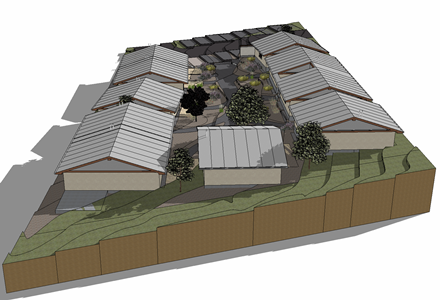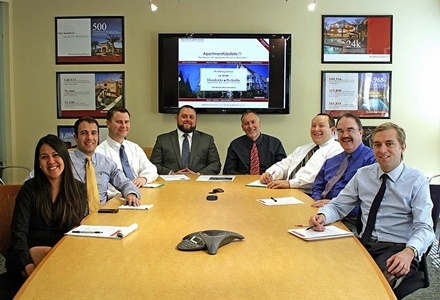|
Alternivest just delivered 3050 Eisenhauer, a 14-unit multifamily community in San Antonio built with compressed earth, the original construction technology. (Is it still bad/possible to track mud in the house?) Alternivest owner David Komet (snapped on site) tells us compressed earthen construction is similar to the adobe techniques originally used to build San Antonio. But he's not just being retro—properties built this way have high thermal mass requiring less energy, are quiet for residents, are nearly unburnable and bug-free, and are market competitive to construct. David lives and works in a high-thermal-mass, historic firehouse and tells us temperature changes are very minimal, so he uses less HVAC and needs fewer ducts in the ceilings. Residents of 3050 Eisenhauer have 12 inches of compacted earth between them, which makes units very quiet. As they say, good earth makes good neighbors (and also made Pearl Buck famous).  Lake Flato designed the community because it specifically wanted to work in the compressed earth format. So why isn't everyone building this way? David tells us it's not easy to do, especially since it's so rare in the US. He had to develop some technology for the property, and the City of San Antonio hadn't worked on such a project before. The biggest struggles were with navigating the code and fire safety—although the materials essentially cannot burn, the City requested a fire rating test for the walls and required commercial-grade sprinklers. (Since David wasn't expecting that, it was a challenge.)  3050 Eisenhauer has another feature that's not common in San Antonio: a California courtyard layout. Although zoning would've allowed David to build a three-story property with 22 units, he wanted to keep it small with a real feeling of community. The courtyard layout improves security and enhances that sense of neighborhood. Alternivest is preparing to break ground on Phase 2 of 3050 Eisenhauer (rendered here), and it's developing a compressed earth building in New Braunfels designed for seniors. And David's always working to improve the technique—next on his list is implementing vaulted ceilings. |
|
 |
Multifamily's Three Paths The darling of commercial real estate continues to skip along happily. Hendricks-Berkadia senior director of research David Delich highlights three multifamily trends to continue all year: 1) Apartments everywhereDavid (left center, with his research team) says developers are active in both lower- and higher-priced submarkets and both big and small builders are shoveling dirt in Texas. The most active: JLB Partners, Greystar, and Trammell Crow, with a combined 21 projects and 7,400 units underway in Austin, San Antonio, and Dallas-Fort Worth. 2) Building in the ‘burbs The majority of development is in the suburbs. In Austin, 1,900 units are underway in the North Travis and Southeast submarkets, where asking rents average are roughly $895/month, compared to metrowide asking rents of $1,026/month. Moreover, 46% of all current projects in the San Antonio metro are in the relatively affordable Bexar County submarket, where asking rents are 25% less than the marketwide rate. Based on the projects under construction, apartment inventory in centrally located submarkets will expand by 6.6%, compared to a 3.5% increase in suburban apartment stock. 3) Finding the finish line Job growth moderated in San Antonio, and now hiring is poised for a rebound. Just 4,500 positions were created in the metro in 2013, following 23,600 new hires in the preceding year. Resurgent hiring in both blue- and white-collar sectors will bolster employment levels this year, as headcounts are predicted to expand by 17,000 workers. In Austin, population and employment growth will persist at a healthy rate, which will limit this year's rise in vacancy to 90 bps, finishing the Q4 at a relatively healthy 5.7%. |
 |
 |
San Antonio's Eastside Gets Help from the FedsIt's name sounds like the next summer blockbuster movie, but San Antonio's Promise Zone is a government designation offering help from federal agencies. Here's President Obama (photo courtesy of the White House) making the announcement that San Antonio is among the first five designations along with Philly, LA, Southeastern Kentucky, and the Choctaw Nation of Oklahoma. For San Antonio's Eastside neighborhood, it means (among other things): federal assistance to create a multi-modal transit hub to enhance access to St. Philip's College, Fort Sam Houston, downtown and other employment centers; razing abandoned buildings; improving street lighting; and partnering with the college to provide instruction in a variety of industries including construction. |
 |





